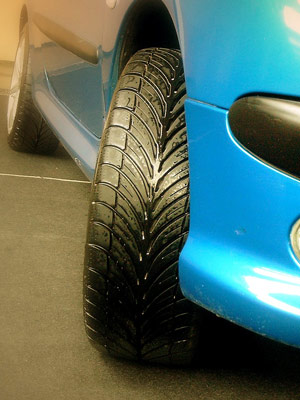The driver of a car must ensure that the tread of the tyres meets the legal minimum of 1.6mm. You can examine your tyres visually, as tyres have tread wear indicators moulded into the design of the tread.  However, tyres may deteriorate gradually. It can then be difficult to identify a loss of performance, for example, slower braking times, that might indicate that tyres are becoming worn. Kwikfit suggests that one of the signs that your tyres are due for replacement is that they do not grip the road as well in poor driving conditions. They advise regular inspections to ensure tyres are inflated to the correct pressure, as this will prolong their life.Michelin identifies some other occasions when you should change your tyres:
However, tyres may deteriorate gradually. It can then be difficult to identify a loss of performance, for example, slower braking times, that might indicate that tyres are becoming worn. Kwikfit suggests that one of the signs that your tyres are due for replacement is that they do not grip the road as well in poor driving conditions. They advise regular inspections to ensure tyres are inflated to the correct pressure, as this will prolong their life.Michelin identifies some other occasions when you should change your tyres:
- When you get a puncture.You should not drive with a puncture, it is not safe and the tyre could become damaged further.
- When your tyre is damagedCheck your tyres after driving over a pothole, kerb or sharp object.
- When you can see abnormal patterns of wearAbnormal wear can be caused by under- and over-inflation of the tyre or by wheel misalignment. It may also occur after emergency braking or an impact.
A weekly check of your tyres will keep you driving safely and at maximum efficiency.
